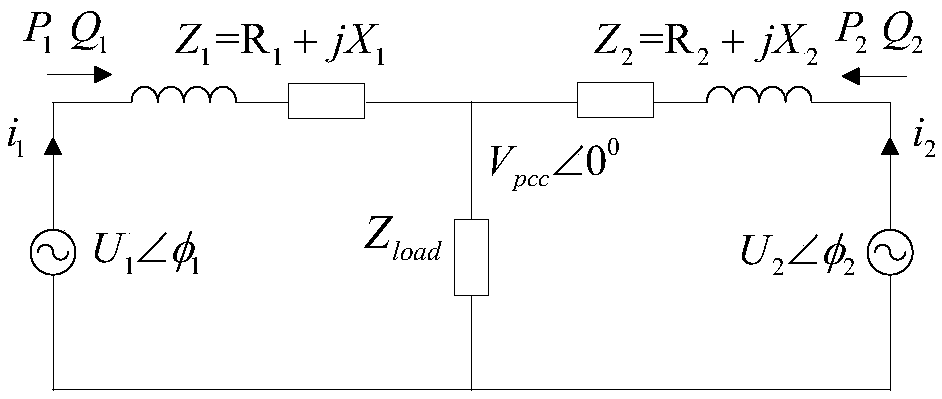Virtual inductive reactance regulator and control method for realizing reactive power equalization of parallel inverter
A control method and inverter technology, applied in the field of microgrid, can solve problems such as power coupling, line impedance difference, reactive power sharing error, etc., and achieve the effect of increasing reliability, improving power quality, and realizing precise distribution
- Summary
- Abstract
- Description
- Claims
- Application Information
AI Technical Summary
Problems solved by technology
Method used
Image
Examples
example (1
[0089] Both inverters adopt traditional droop control, and only supply power to load 1 within 0-1s: the active and reactive power of load 1 are 8kW and 10kVar respectively, and load 2 is put into power supply in the first second, and will be turned on in the second second. After its removal, the system stabilizes and returns to a load of only 1. The active and reactive power of load 2 are 8kW and 8kVar respectively.
[0090] Figure 8 shows the simulation results of the output voltage of the active power and reactive power inverter obtained when the traditional droop control is adopted.
[0091] Depend on Figure 8-a It can be seen from the active power simulation result shown in the figure that even though the traditional droop control can share the active power well, it takes a long time to achieve the equal share, which takes 0.4s, and the operation efficiency is low; Figure 8-b Comparing one phase of the output voltage of the two inverters, it can be seen that due to the...
example (2
[0093] Both inverters use the virtual inductive reactance regulator to calculate the virtual inductive reactance for power decoupling and eliminate line impedance difference, and the load switching is the same as in example (1).
[0094] see Figure 9-a~9-c .
[0095] The simulation results of inverter output voltage, active power and reactive power obtained by adopting the control method of the invention. In the figure, it can be seen that the introduction of virtual inductive reactance realizes power decoupling and eliminates the difference in equivalent line impedance between the two inverters. Figure 8-a , the transition time for equal sharing of active power is shortened, only 0.14s is needed, the output voltage difference between the two inverters is significantly smaller, and the effect of equal sharing of reactive power is significantly improved. Q 1 , Q 2 The relative error is within ±2%.
PUM
 Login to View More
Login to View More Abstract
Description
Claims
Application Information
 Login to View More
Login to View More - R&D
- Intellectual Property
- Life Sciences
- Materials
- Tech Scout
- Unparalleled Data Quality
- Higher Quality Content
- 60% Fewer Hallucinations
Browse by: Latest US Patents, China's latest patents, Technical Efficacy Thesaurus, Application Domain, Technology Topic, Popular Technical Reports.
© 2025 PatSnap. All rights reserved.Legal|Privacy policy|Modern Slavery Act Transparency Statement|Sitemap|About US| Contact US: help@patsnap.com



